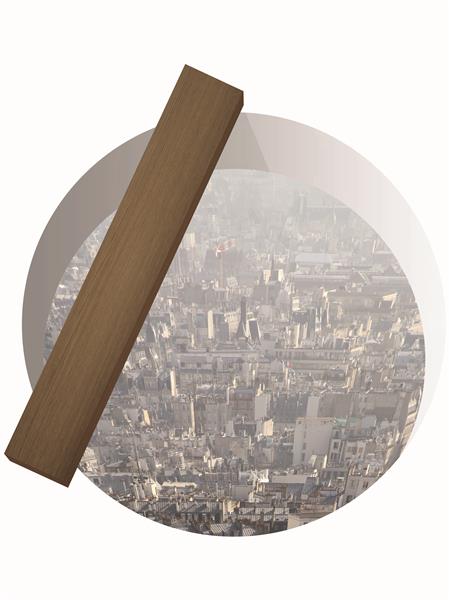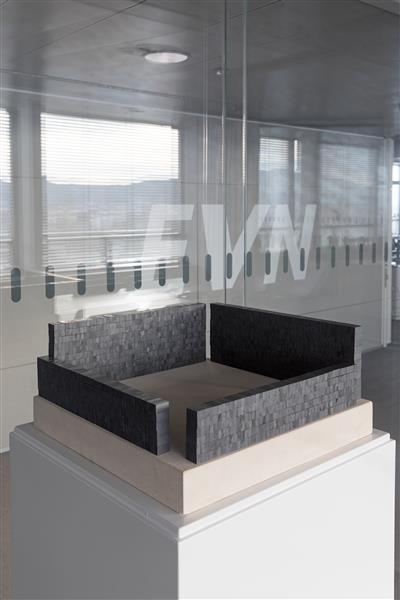Yet, The Alternatives on Offer
Philipp Timischl
UV-direct print on resin on canvas, flat-screen and video
159 × 105 × 5 cm; video: 2'
2014
Acquisition 2014
Inv. No. 0272abc
The series Yet, The Alternatives on Offer, by artist Philipp Timischl, comprises multiple forms of viewing. First exhibited at Galerie Emanuel Layr in 2014, Timischl created a screen-on-screen effect whereby the five works on canvas sit above the rectangular field of freestanding flatscreen televisions. The ʻvideo sculptureʼ in the evn collection is arrayed on a vinyl print that simulates a wooden plank over a hole, which offers a birdʼs eye view of Paris.
In 2015, Hans Ulrich Obrist and Simon Castets interviewed Philipp Timischl as part of the long-term, international, multi-platform research project 89plus, which investigates the generation of innovators born in or after 1989 through conferences, books, periodicals, residencies and exhibitions. This excerpt from the interview addresses some of the concerns that Timischl addresses in his practice:
You’ve been working a lot with video stills as sculptural objects in your recent work, and this project will include large banners depicting video stills. How do you perceive the physicality of video? What drives you to translate these time-based digital works into a static physical form?
Yes, the banners in this exhibition will show video stills of a project I recently filmed. I tried to do a sort of behind the scenes/making of a porn movie. Itʼs me having fun with this guy I like, a third person filming it and then a fourth person editing the footage. I donʼt really know what to do with it yet or how to present it in the “right” way. I donʼt want it to be shocking or about porn. Itʼs certainly much more explicit and less vague than what Iʼve done in the past. Showing stills from it allows me to just hint at something that might be finalized in the future. I am not trying to stretch the boundaries of what video or technical products can do. I use consumer products. I just order the screens and use whatever they come with. I also buy all my art supplies at a common art supply store. I like the limitations of it. My friend called me illiterate the other day because I have no idea about programming languages.
He was right, I think. It’s the future and it seems limitless. But I canʼt work within that.
Youʼve made photographic vinyl-prints that are installed on the walls and on the floor. At first sight, they appeared to be extensions of the actual architectural space, but were in fact scenes from your previous exhibition spaces and some cityscapes. Can you tell us about the significance of these optical illusions and representations?
The anamorphic banners I produced for the show only function from one specific viewpoint in the space and come to full effect when viewed through a screen like your phone, for example. I liked the idea of forcing the audience to look at the show from one specific viewpoint and therefore also see the sculptures from the angles I decided on. A lot of people just stand in front of my sculptures as if they were paintings but sometimes itʼs important to walk around and realize there are also elements on the backside. On the other hand, I also found it funny to start working on an exhibition by thinking about the documentation photography first, as it usually happens last. To create these anamorphic illusions you have to decide from which point in the space you want to photograph your documentation later and model the arches accordingly. One of them also failed because I didnʼt realize there was an actual wall where the photographer was supposed to stand.
Hans Ulrich Obrist, 2015 (translation: Virginia Dellenbaugh)
Continue reading
Publications
21er Raum im 21er Haus Wien, Vienna 2016
evn collection. 95–2015 Jubilee, Vienna 2015, p. 341–345

